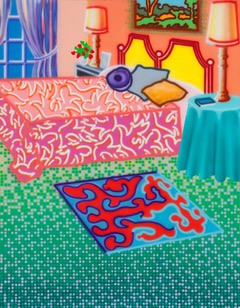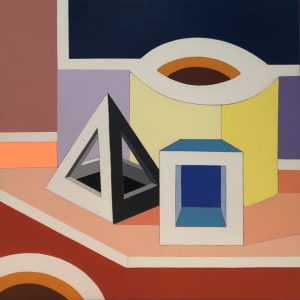Hi everyone,
It’s Amy here again with my Sunday guest blog, this week looking at the life and work of Howard Arkley.
Arkley was a Melbourne artist, spending most of his life and painting career within Australia. He was a draftsman, sculpturer and photographer, however predominantly known for his incredibly skilled airbrushed paintings. Arkley’s unique style; deliberately creating hyperreal scenes of houses, architecture and suburbia was where the ordinary morphs into the extraordinary.
Arkley was known to be a colourful and extroverted character which could be seen in his artworks, he worked with passion and intensity to create a new and refreshing view of suburbia and Australian culture which made him a key contributor to Australian 21st century art.

Howard Arkley, Family Home – Suburban Exterior, 1993.
Artists life:
On a family outing to the National Gallery Victoria was where Arkley had his first exposure to Surrealism and instantly fell in-love with the Australian surrealist artist, Sidney Nolan. From then on, he drew insatiably, covering every surface from books to napkins with doodles. In the first year of his art studies at Prahran College of Advanced Education in Melbourne he was introduced to the airbrush, which at the time was only ever used for shading. Arkley redefined the tool to work with extreme precision. Arkley had his first exhibition at age 25 with at Tolarno Galleries in Melbourne. Interestingly enough these works had no colour, they are known as the ‘white’ paintings. These explored modernist and abstract art styles and the symbolism of black and white in Zen Philosophy. Arkley has always stayed true to his medium of airbrushing however his artistic style went through great evolutions in colour and subject. Arkley soon became very involved in the Melbourne art and music scenes; punk and pop inspired him and started his journey to bridge the gap between High Art and Pop culture.
Artistic Inspiration:
I appreciate Arkley’s pure honesty and transparency when it comes to what inspires his artworks, he doesn’t try to create extravagant intellectual connections, he is simply draw and attracted to everyday suburban scenes, interiors and urban infrastructure and as for colour palettes he is inspired by pop-art posters, commercial signage and even food packaging.
Arkley and his first wife and fellow artist Elizabeth Gower travelled Europe and New York for artistic education and inspiration, photographing Art Novae and Art Deco Architecture and doorways which he intended to use as motifs for his future works. Upon returning to Australian, Arkley became far more aware of his own, local cultural environment, finally convincing himself that the Australian vernacular was just as important, and that the suburban flywire was just as strong as a Parisian arch. I admire Arkley’s patriotic manor in which he created an image of cultural identity for Australia that hadn’t been used before.

Howard Arkley, Outside-Inside-Out, 1995
Arkley used these patterns in his abstract works and took them back into his architectural and interiors as panels and textures. He felt as though all houses were filled with rich textures and patterns; pine, carpet, brick, doors, fences, footpaths etc. Suburbia was an important subject as it was Arkley’s life, his childhood years and his formative years; personally, and artistically. I believe he wanted to create art that every Australian could recognize and embrace while simultaneously rejecting the exclusivity that can exist in the modern art world.
“Australian art has been dominated by the rural landscape and I think there is something false and overrated – it’s romanticised or, at the very least, lopsided. Most of the population live in an urban environment. This environment affects us – the kinds of people that Australians are, and the way we behave. It affects our formative years, so it is a very important element.”

Howard Arkley, Rococo Rhythm, 1992.
Artists Ideals:
Arkley created a connection with his medium early on in his career, Arkley liked the idea of making a painting without making a physical mark. He admits to never seeing himself as a ‘painterly painter’, he enjoyed creating art the most when it could be done quickly and with as minimal physical effort as possible; to Arkley it was all about creating the final image. He deemed most of the artistic world to snobbery and enjoyed the idea of other artists resenting his artistic ideologies and style.
Mastering his medium was what allowed Arkley to create such unique art works and help him stand out in the wave of new and emerging artist from and booming creative scene in Melbourne.
He manipulated the airbrush to the point in which he could use it like a pen, using tape and stencils to create to create shapes and patterned panels to make up the bodies of his work. Arkley intentionally used synthetic polymer airbrush paint on canvas to create this flat and glossy appearance, to resemble that of mechanically reproduced imagery. He wanted his paintings to look like the reproduced images, the furthest thing from original artworks with visible brush strokes and physical 3D marks left. He wanted his images to look like those in the books and magazines he learned and drew inspiration from.
Arkley liked airbrushing because it created physical distance between him and the artwork, he painted the suburbs because they were familiar to him and all Australians however he almost never painted suburban scenes or interiors from his own life, with the exception of Family Home – Suburban Exterior done towards the end of his career. He always drew inspirations from interior magazines or real estate advertisements, creating this distance between his personal life and his artistic influences.
Arkley was an incredibly talented and fascinating artist, constantly going against the grain of the modern art world. Wanting to create with as minimal time and effort as possible, aiming to produce pieces that resembled nothing of a human touch, using anything he was attracted to as inspiration and honouring the most humble Australian vernacular throughout his work.
_________________________________________________________________________________________
Q and A with Jasmine..
Do you try to create distance between your artwork’s subjects and personal life? Or is each piece a display of your current emotions, thoughts and feelings?
I am constantly drawing on my own experiences and emotions as subjects for my work, but it is usually so they can be examined in the light of the universal human experience. For example, I have a work in an exhibition which opened this weekend in Brisbane titled; The Elephant in the Room. This painting uses shapes as a kind of still life, with the elephant being disproportionally large. The viewer can take their own meaning from this work, whether it be personal or the bigger issues we choose to not deal with day to day.

Jasmine Mansbridge, Elephant in the Room, 2020.
How do you find your colour palette? Do you draw inspiration form manmade designs or natural elements?
I am defiantly inspired by nature and some of the best colour combinations are found in it. In saying that though my work is largely intuitive and I mix colours as to how I think they will best suit the individual pieces. It is also influenced by my mood, my surroundings and the seasons.
Arkley’s creativity was constant however his inspiration and style changed dramatically, can you relate to this on your artistic journey?
Yes as I think so often one process leads to curiosity about another and so on and so forth. For example a large wall with influence a painting etc.. and now I am doing Sculpture too which is an extension of the shapes I have used in painted works. It really is an exciting thing to be able to make things and to continue to push ideas.
_________________________________________________________________________________________
As I have just completed my studies in Architecture I am enjoying researching different artists who reflect my interests and also elements of Jasmine’s work. If there is anyone you would like to know more about you can get in touch with me here.
Have a great week..
Amy X
Jasmine has work in two group exhibitions open now.
In London INDIAN SUMMER with Artistellar.
THE LIGHT WITHIN with Vanrensburg Galleries.


Recent Comments